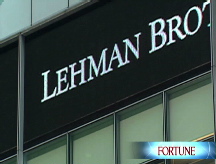Paulson pulls the fire alarm
FRIDAY EVENING, SEPTEMBER 12
 |
| Early in the discussions, Treasury Secretary Paulson made it plain that taxpayers would not bail out Lehman. |
Henry Paulson, the Treasury secretary, and Christopher Cox, the chairman of the SEC, flew up from Washington on Friday for a 6 p.m. meeting with Geithner to discuss what the plan for the weekend would be. Meanwhile, Ben Bernanke, the chairman of the Federal Reserve, stayed in Washington to coordinate a response with the leaders of other central banks around the globe. Going into the weekend, there were two potential suitors for Lehman Brothers - Bank of America and London-based Barclays.
With Geithner at his side, at 6:15 p.m., Paulson stood before the assembled Wall Street CEOs and delivered a harsh message, according to a source there. "There will be no bailout for Lehman," Paulson said. "The only possible way out is a private-sector solution."
At that moment, Ian Lowitt, Lehman's CFO since June 2008, knew it was over for his firm. That night "[government] officials...indicated that emergency federal funding would not be forthcoming to stabilize Lehman Brothers and provide the liquidity needed for its operations," he wrote in an affidavit accompanying the firm's September 15 bankruptcy filing.
Unlike what the government did for Bear Stearns in March, there would be no taxpayer money made available to support a Lehman bailout. According to one government official, there was a lot of rhetoric going into the weekend both from the Congress and from people around the Treasury about how the solution for Lehman should not involve public money.
Whether that was a clever negotiating tactic or the line in the sand that would not be crossed, the Treasury secretary had set the definitive tone for the weekend. The future of Lehman Brothers, a 158-year-old firm with origins as a dry-goods store and cotton trader in Montgomery, Alabama, rested solely with men sitting around the table in the Fed's ornate boardroom at 33 Liberty Street. Come up with a private market plan in 48 hours to save the firm from insolvency or suffer the consequences of a catastrophic unwind of Wall Street's complex and internecine financial relationships.
After Paulson announced that there would be no government bailout for Lehman, he and Geithner laid out three possible contingency plans for the titans of Wall Street to work on during the weekend. Door Number One: Investigate whether there could be a "private-sector liquidation consortium" that would somehow finance a gradual sale of Lehman's assets outside of bankruptcy. Door Number Two involved the assembled bankers closely examining Lehman's most damaged assets and then forming a consortium to finance those that neither Bank of America nor Barclays wanted to take, allowing an acquisition of the remainder of Lehman to occur. Door Number Three was to contemplate how the free world could contain the damage in the event there was no solution possible. The first idea quickly became untenable and nobody, at the outset, had the slightest interest in seriously considering the third scenario.
The focus of the meetings became how to finance the Lehman assets that neither Bank of America nor Barclays wanted. (Representatives of Bank of America, Barclays and Lehman were in and around the Fed that weekend but were not included in many of the meetings of the wider group because of their stake in the outcome.)
NEXT: LATE FRIDAY NIGHT Bank of America bows out ![]()
-
 The retail giant tops the Fortune 500 for the second year in a row. Who else made the list? More
The retail giant tops the Fortune 500 for the second year in a row. Who else made the list? More -
 This group of companies is all about social networking to connect with their customers. More
This group of companies is all about social networking to connect with their customers. More -
 The fight over the cholesterol medication is keeping a generic version from hitting the market. More
The fight over the cholesterol medication is keeping a generic version from hitting the market. More -
 Bin Laden may be dead, but the terrorist group he led doesn't need his money. More
Bin Laden may be dead, but the terrorist group he led doesn't need his money. More -
 U.S. real estate might be a mess, but in other parts of the world, home prices are jumping. More
U.S. real estate might be a mess, but in other parts of the world, home prices are jumping. More -
 Libya's output is a fraction of global production, but it's crucial to the nation's economy. More
Libya's output is a fraction of global production, but it's crucial to the nation's economy. More -
 Once rates start to rise, things could get ugly fast for our neighbors to the north. More
Once rates start to rise, things could get ugly fast for our neighbors to the north. More








